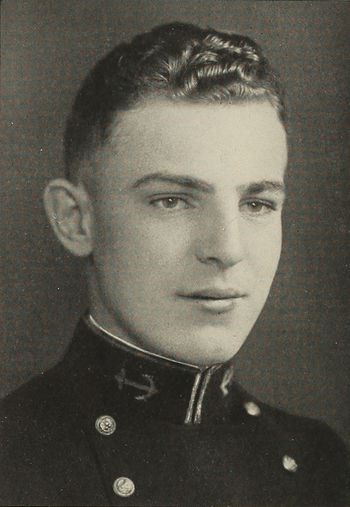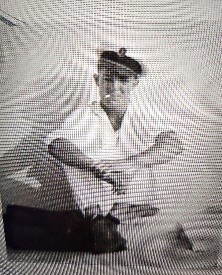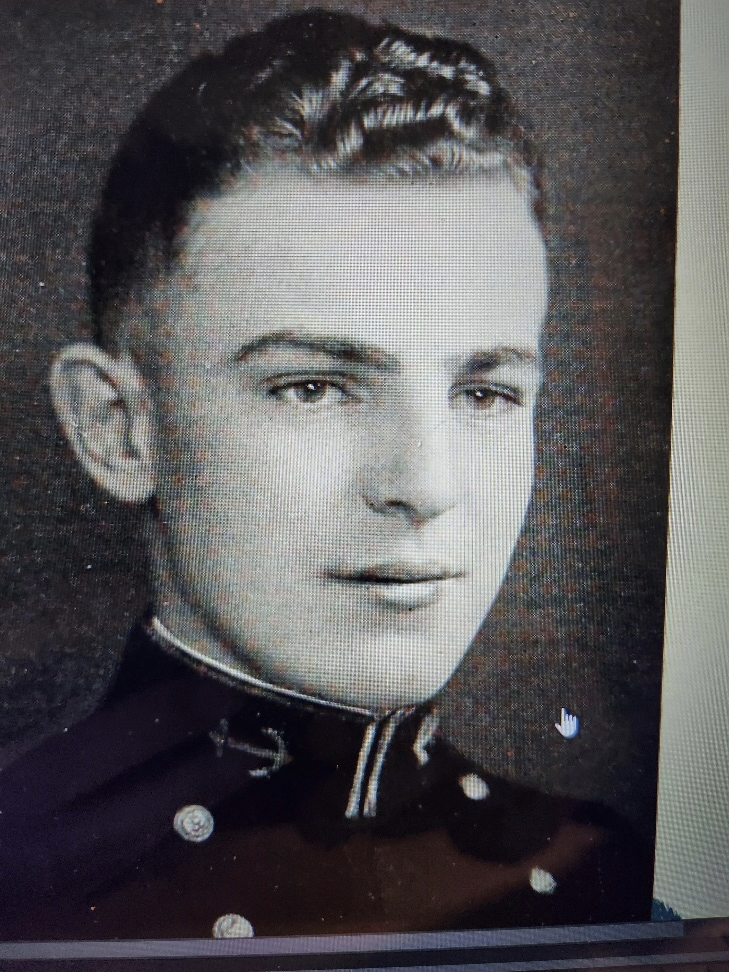WALTER A. HERING, LCDR, USN
Walter Hering '38
Lucky Bag
From the 1938 Lucky Bag:
WALTER ANDREW HERING
Fairbanks, Alaska
Walt, Eskie
From the land of dog sleds and the midnight sun comes this frozen specimen of humanity. Always the first to gripe about the abnormal lowness of Maryland temperatures, Walt, nevertheless, gets great pleasure out of spinning yarns from the land of the igloo, while, like Tennyson, he smokes infinite tobacco. Academically he is well off even though he found it a tight squeeze between the Steam Department and the great unknown his Plebe year. Walt has something on the ball at every pitch; one seldom finds him at sea without his water wings. A veritable Napoleon at the dinner table, a whirling demon on the basketball court, a monster to the Plebes, and no slouch with a slipstick, he has chiseled himself a permanent niche in the memories of '38.
Trident 4, 2; Crew 4; Batt. Basketball 4, 3, 2, 1; Lucky Bag; M.P.O.
On page 479, in the Editor's section: "Obie Parker told the story in pictures. This is largely Obie’s book. Hering and Dimmick stooged faithfully. The rest of us stooged too, but not faithfully."

WALTER ANDREW HERING
Fairbanks, Alaska
Walt, Eskie
From the land of dog sleds and the midnight sun comes this frozen specimen of humanity. Always the first to gripe about the abnormal lowness of Maryland temperatures, Walt, nevertheless, gets great pleasure out of spinning yarns from the land of the igloo, while, like Tennyson, he smokes infinite tobacco. Academically he is well off even though he found it a tight squeeze between the Steam Department and the great unknown his Plebe year. Walt has something on the ball at every pitch; one seldom finds him at sea without his water wings. A veritable Napoleon at the dinner table, a whirling demon on the basketball court, a monster to the Plebes, and no slouch with a slipstick, he has chiseled himself a permanent niche in the memories of '38.
Trident 4, 2; Crew 4; Batt. Basketball 4, 3, 2, 1; Lucky Bag; M.P.O.
On page 479, in the Editor's section: "Obie Parker told the story in pictures. This is largely Obie’s book. Hering and Dimmick stooged faithfully. The rest of us stooged too, but not faithfully."
Loss
Walter was lost when USS Hazelwood (DD 531) was struck by a kamikaze on April 29, 1945 while operating off the coast of Okinawa. He was in the process of taking command of the ship at the time.
Nine other officers and 67 crew were lost in the attack.
Biography
Walter's biography was authored by Majel Hering Jeffus, his niece, and provided via email on December 18, 2023.
Walter Andrew Hering was born on July 18,1917 in Fairbanks, Alaska to the pioneering family of Edward Arthur and Agnes Potts Hering. Walter was the tenth of eleven children. At the age of ten, due to the death of his father, Walter along with the rest of the kids had to go to work after school to help support the family. A story told to me by my father, Tom Hering, who was 2 years older: Walter and Dad got jobs selling newspapers on the street for The Daily News Miner. Somehow, they always seemed to end up at the wooden fence that separated the “Red Light District” from the rest of the small town, and they would peek through the knot holes to see what they could see. Another story Dad told me was when Walter was about 4 and he and Dad would sleep out on the front porch in the summer. Dad would tell Walter ghost stories how the case eggs, that were stored on the porch, would come and get him during the night. It scared Walter so bad that he refused to go anywhere near the front porch even in the daylight.
The following snippets from The Fairbanks Daily News Miner will give a snapshot of who Walter was as a child and teenager.
Fairbanks in Review 10 Years Ago Today, April 13, 1939:
April 13, 1929: The junior high school band made its first public appearance last night and made a fine impression. Walter played clarinet and Thomas played saxophone.
Lake Harding Picnic draws Large Crowd, August 11, 1930:
Land Events: 100-dash for boys under 16, Walter took 3rd place. In the potato race for boys 16 and under, Walter took 2nd place. In the water event Walter’s polo team took 1st place
Fairbanks High School Band and Orchestra Concert Great Success, April 22, 1933:
The band played a concert to raise funds to buy new instruments lost in the school fire last December. Walter played clarinet and Tom played saxophone.
Truck Driver’s Quick Action Saves Life, February 12, 1934:
Eileen Sturgell is suffering only slight bruises and shock today thanks to the quick thinking and quick action of Walter Hering, who was driving an express truck loaded with two tons of coal, which ran over Eileen. Walter saw the girl and her friend and noticed that they were off the road. When the truck was a few feet from where the girls were walking, Eileen, who was wearing mukluks, slipped and slid into the deep rut which had been worn in the hard snow. Walter, seeing that he was too close to stop the truck, quickly turned the wheel and applied full brakes. The truck, however, could not leave the rut, and part of wheel ran over Eileen’s left leg and left side. Ex-rays revealed no broken bones.
Fairbanks School Notes, May 22, 1934:
The high school students are all very proud to have two of their fellow classmates receive highest places in the Phipps’s Scholarship examination. Only Senior boys can take the examination. Students from all over Alaska have competed for this award and this year the prize was won by Walter Hering. Tom Hering was the next highest.
History, May 31, 1934:
Yesterday, the seniors sponsored a Class Day program. The Last Will and Testament of Walter Hering was read: To Philip Anderson, we leave all of Walt Hering’s old cords, to be washed and pressed at least once during the year. Walter’s Prophecy was written and read by Katherine Peterson: And now our dear old Walter brave, an admiral dignified. He carries away the honors, great. To others they are denied. The Torch Honor Society pins were presented. Walter and Tom received gold pins.
Although Walter and Tom were inseparable and well known for their good-natured pranks, Walter and Tom both graduated from Fairbanks High School in 1934 with straight A grade point averages. Walter was valedictorian. On July 17, 1934, Walter was appointed Midshipman from the territory of Alaska. It was quite a cultural shock to an eighteen-year boy from a small town with a graduating class of 18 to arrive at the naval academy.
From the Alaska Miner (Fairbanks, Alaska) February 15, 1938:
Advices received here by recent mail bring the good news that two Fairbanks boys now attending the U.S. Naval Academy at Annapolis are making splendid records and are having a wonderful experience there. They are Midshipman Walter Hering, who will graduate from the academy with the class of 1938, and Midshipman Erwin Frederick Wann Jr. class of 1940. The boys write that a number of Alaskans have visited them during the winter. Midshipman Hering and Wann both had the pleasure of making a cruise with ships of the North Atlantic fleet on their visit to Europe last summer, and got to see Germany, England and other countries during shore leave. Berlin and London were among the cities they visited.
Walter graduated June 2, 1938 with a Bachelor of Science.
YouTube: Graduation Day at US Naval Academy 1938
Their Commander in Chief, Franklin D. Roosevelt, gave the graduates some fatherly advice, “Before you actually become Bachelors of Science, let me stress that in the days to come you do not place to much emphasis on the word bachelor.”
On June 2, 1938, Walter accepted the appointment and executed his oath of office. He was commissioned Ensign. Walter was assigned to USS Salt Lake City (CA 25) for a month; reported July 5, detached August 12, 1938. Further assigned to USS Concord (CL 10) for duty; reported August 13, 1938. Walter was detached from Concord on June 29, 1939.
Fairbanks Briefs October 11, 1938:
Ensign Walter Hering is aboard the cruiser Concord, reported in Wednesday’s dispatches as sailing from San Diego for Europe to care for American war refugees. He visited here this summer.
Walter was ordered to USS Warrington (DD 383) on April 11, 1939. Reported on August 4, 1939. On October 13, 1941, Walter was promoted to Lieutenant (junior grade), to date from June 2, 1941. On June 15, 1942, he was appointed by the President to the grade of Lieutenant. Notice of appointment promulgated in ALNAV 119 dated 15 June 1942. He then became executive officer of Warrington.
Taken from The Warrington Wanderer, Volume 1, Number 1, February 1, 1943, an onboard newsletter published by the crew of USS Warrington:
A Very Good Record
The Warrington came to the West Coast and joined the Battle Fleet in July, 1939. From this time until April, 1941 she operated as a member of Destroyers Battle Forces, basing for approximately ten months at San Diego, California and the remainder of the time at Pearl Harbor. During this period the Warrington made the following records:
1. Tie for first place in gunnery competition for destroyers with their “short range” guns (the “Battle E”).
2. The red “C” for communication efficiency.
3. The official designation for two years as the “smartest ship” in Destroyer Squadron NINE.
4. The unofficial designation of being “The Smartest Ship” in Destroyer Battle Force.
During the first problem in 1940, Secretary of the Navy, Charles Edison, and Rear Admiral Ernest J. King, now Commander-in-Chief of the U.S. Fleet, made a two-day cruise on the Warrington. During these two days, the ship rescued a pilot from one of the Saratoga’s planes which had crashed.
In April 1941, the Warrington again returned to the Atlantic and operated with the South Atlantic Squadron until October. On the fateful day, December 7, 1941, the Warrington left Charleston Navy Yard upon completion of an overhaul. Since then, she has been round, ready to deliver the death blow to an enemy which might appear.
The following is taken from a letter to his brother, Tom, on January 28, 1945. This letter was written while his new ship, USS Patterson (DD 392) was docked at Ulithi preparing for the invasion of Iwo Jima.
They have loosened up a bit on the censorship out here so I can give you an idea of what we are doing. When the war first broke out we had a crack at the North Atlantic which I didn’t like. Then we were moved to running between Panama, Tahiti, and South America. It was soft duty but rather dull. Did manage to get on some fine drunks in Lima, Peru as we had a bunch of heavy drinkers on the Warrington. Then we shifted to the South Pacific and made some interesting trips there. Got to Australia once and went kangaroo hunting but didn’t get anything. I left the ship at Guadalcanal and flew back in September of 43.
Walter was ordered to the Twelfth Naval District for temporary duty and further assignment. Detached October 1, 1943. He was then ordered to Fleet Sound School, Key West, Florida for temporary duty under instruction. Reported October 30, 1943. Detached November 14, 1943.
Ordered to Naval Training Station, Naval Operations Base, Norfolk, Virginia for temporary duty under instruction. Reported November 18, 1943. He was then ordered to Federal Shipbuilding and Dry Dock Company, Kearny, New Jersey for duty in connection with fitting out USS McNair (DD 679). Detached December 29, 1943. Ordered to USS McNair for duty as executive officer. Reported December 30, 1943.
From his letter:
Then after the McNair was started, I left the states again in March (1944) and have hit most everything since, Saipan, Tinian, and Guam.
Walter was promoted to the rank of Lieutenant Commander on March 1, 1944. On July 28, 1944, he was ordered to USS Patterson (DD 392) for duty as commanding officer. He reported August 22, 1944. Walter and his crew participated in the bombardment of Yap Island on September 8th. From there he proceeded to the Palau Islands to guard fast carriers giving direct support to the landing troops there until October 9th.
The following is taken from Wikipedia's entry on USS Patterson:
Patterson made a high-speed run with attack carriers to blast enemy defenses on Okinawa and the entire Kerama Retto Chain. From there the fast carrier task forces approached the Philippines to rain destruction on enemy air installations in Northern Luzon, thence proceeded to the coast of Formosa, for air strikes launched 12 October. That evening and through the following day, Patterson helped fight off and destroy enemy aerial raiders that approached her carrier task group.
For his actions of October 12th and 13th 1944 Walter was awarded the Bronze Star.
From: History of United States Naval Operations in World War II-Leyte, pg. 331:
The Battle off Cape Engano: On October 25th [1944], resuming stern chase, Admiral Dubose sent destroyers Clarence L. Bronson, Cotton and Patterson ahead to make a successful torpedo attack on the Japanese destroyer Hatsuzuki. This was successful in slowing up Hatsuzuki. The cruisers illuminated her with star shells, and slowly and deliberately brought the Hatsuzuki under gunfire and saw her explode and sink.
From book: Kamikaze to Die for the Emperor pg.27:
Belleau Wood was perhaps fortunate that the Kamikaze had dropped its bombs before impact. Even so, it took the best part of three hours to get the fires under control and ninety-two officers and men were killed with a further fifty-four injured. The destroyer Patterson (DD-396, Lieutenant-Commander Walter A. Hering) alone rescued sixteen men who had been blown over the side of the ship, though sadly two of those died aboard her and were buried at sea the following day.
Patterson also rescued men from the carrier Franklin and escorted the damaged carriers to Ulithi.
From the Dictionary of American Naval Fighting Ships:
Patterson helped protect attack carriers providing air cover to convoys approaching the Philippines until 9 December. She then proceeded independently to Kossol Roads, Palau Islands. There, she joined the screen of an escort carrier-bombardment task group that sailed 10 December to provide heavy gunfire support and air cover for the initial landings on Mindoro Island. For seven days the destroyer remained in the Sulu Sea, fighting off frequent suicide attacks of enemy aerial raiders that closed her carrier task group formation. There was a brief replenishment at Palau before Patterson again sailed with escort aircraft carriers, this time to support the invasion landings at Lingayen Gulf, Luzon, P.I. She rescued survivors of the kamikaze-damaged escort carrier Ommoney Bay 4 January 1945, and survivors of destroyer Stafford and escort carrier Manila Bay the following day. She shot down a suicide plane diving on carrier Salamaua 13 January, remaining on guard for carriers in support of the Lingayen Gulf invasion landings until the 17th. She then proceeded to Ulithi in the Carolines to prepare for the impending invasion of Iwo Jima.
From letter to his brother January 28th, 1945:
Expect that you are still a confirmed civilian at heart-can’t say that I blame you as everyone out here is and there are times when I weaken myself. We picked up an aviator who was down at sea and I talked him out of his .38 S and W. It is a nice one.
They have kept us busy as hell which helps the time to pass and these things are usually pretty interesting, particularly after they are over. The Patterson is a damn good ship and I am very proud of her. We have done pretty fair in all of them. I still have a lot to learn in handling the ship but guess I will make out o.k. I put a few dents in her again this morning coming along side in a hell of a wind, but it doesn’t bother me too much. Have a good bunch of officers---all reserves except a couple of young navy school boys. We had a beach picnic the day before yesterday. I scared up a few quarts of whiskey and a lot of beer and we went over to an island here and knocked them off.
From Wikipedia:
Sortied from Ulithi on February 10th enroute to Iwo Jima via Siapan, Patterson was assigned to the CVE groups whose mission was to provide direct air support for the amphibious forces enroute to Iwo, during the landings, and subsequent seizure of the island. On the evening of February 21st, when the formation was attacked by a group of enemy torpedo planes that had been reported as planes from the Saratoga. As a result of this action the Bismarck Sea was sunk. The Patterson rescued 106 survivors, and with three other ships remained in the area until the next morning to make a thorough search for any other survivors. The search was negative. On March 1, 1945, the Patterson was still steaming in the Iwo Jima area with the support carrier groups. By March 10th the assault phase at Iwo had been successfully carried out and the support carrier groups were released. As a result, the Task Group of which Patterson was a unit proceeded to Ulithi arriving the morning of March 15, 1945. For a period of approximately a week the Patterson sat at anchor making urgent repairs to machinery and replenishing food stocks, ammunition, and necessary stores. During this period at anchor, on March 17th Lt. Commander Walter A. Hering, USN, was relieved as commanding officer.
According to Walter’s service record he was ordered to USS Hazelwood (DD 531) as commanding officer on January 24, 1945. Since Hazelwood sailed from Ulithi on March 14, 1945 Walter was probably onboard to take over command.
From Wikipedia:
Hazelwood was with a fast carrier force to provide air cover and shore bombardment for the invasion of Okinawa. After the invasion on April 1st, Hazelwood operated off Okinawa on radar picket and escort patrols through intense Japanese air attacks. On Saturday afternoon, April 29th the carrier group she was shepherding was attacked by kamikazes who dove out of low cloud cover. Hazelwood, all guns blazing maneuvered to avoid two Zeros. A third screamed out of the clouds from astern. Although hit by Hazelwood’s fire, the enemy plane careened past the superstructure. It hit #2 stack on the port side, smashing into the bridge, and exploded. Flaming gasoline spilled over the decks and bulkheads as the mast toppled and the forwarded guns were put out of action. Ten officers and 67 men were killed including the Commanding Officer Volckert P. Douw and the incoming Commanding Officer Walter A. Hering.
From "Aircraft Carrier" by J. Bryan, III:
April 28th [1945]. At sea
As we stood away, one of the Hazelwood's officers took me up to the bridge and introduced me to their skipper, Comdr. Volckert P. Douw, a crisp, smart-looking man, with the warmest smile I've ever seen. We chatted a few minutes, then he said, "I bet you don't know who you're talking to. No? I'll tell you: you're talking to the happiest guy in the whole goddamn Navy! See that man standing there?"—he pointed to the other wing of the bridge [to Walter]—"That's my relief. He's going to take over in a couple of days, and I'll go home and see my wife and kids for the first time in God knows when."We were coming alongside another CVE, the Attu, which was giving me a lift to Guam, so I told the skipper goodbye and wished him well. He had no messages for me to send his wife; he thought he'd get home before I would.
…
April 30th [1945]. At sea
… This morning [my friend] Hays took me up to the bridge and gave me the long glass and pointed to a destroyer on our starboard beam. "Look at that mess," he said.Her bridge was smashed flat. Her foremast was hanging over the side. The starboard 40mm mount was lying on the deck.
Hays said, "A kamikaze hit her Saturday afternoon, just after you came aboard. I saw the dispatch, but I've forgotten the exact number of casualties. I know she's requesting a new skipper."
I put the glass on her bow. Her number stood out clearly: "531"—the Hazelwood.
The happiest guy in the whole goddamn Navy
A million laughs, chum—a million of 'em!
In addition to the Bronze Star Medal mentioned above, Walter received the Purple Heart, the American Defense Service Medal (Fleet Clasp), and the Asiatic-Pacific Area Campaign Medal with 2 bronze stars .
Walter's wife was listed as next of kin.
Walter is remembered at the Courts of the Missing in Hawaii.
Photographs
The "Register of Commissioned and Warrant Officers of the United States Navy and Marine Corps" was published annually from 1815 through at least the 1970s; it provided rank, command or station, and occasionally billet until the beginning of World War II when command/station was no longer included. Scanned copies were reviewed and data entered from the mid-1840s through 1922, when more-frequent Navy Directories were available.
The Navy Directory was a publication that provided information on the command, billet, and rank of every active and retired naval officer. Single editions have been found online from January 1915 and March 1918, and then from three to six editions per year from 1923 through 1940; the final edition is from April 1941.
The entries in both series of documents are sometimes cryptic and confusing. They are often inconsistent, even within an edition, with the name of commands; this is especially true for aviation squadrons in the 1920s and early 1930s.
Alumni listed at the same command may or may not have had significant interactions; they could have shared a stateroom or workspace, stood many hours of watch together, or, especially at the larger commands, they might not have known each other at all. The information provides the opportunity to draw connections that are otherwise invisible, though, and gives a fuller view of the professional experiences of these alumni in Memorial Hall.
July 1938
January 1939
October 1939
June 1940
November 1940

The "category" links below lead to lists of related Honorees; use them to explore further the service and sacrifice of alumni in Memorial Hall.

